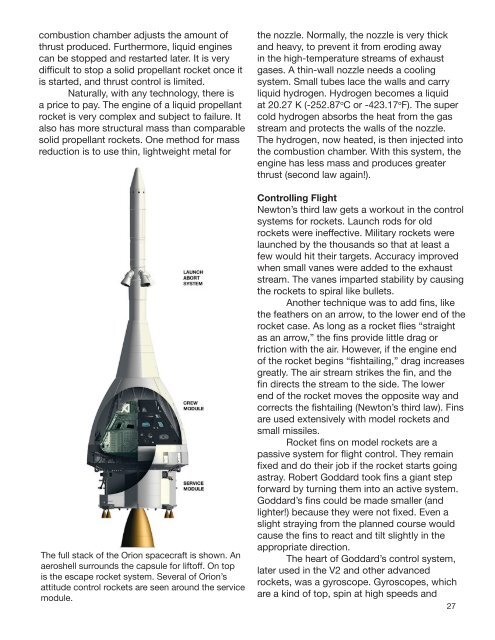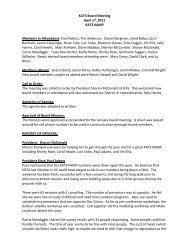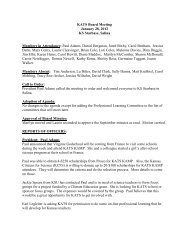Create successful ePaper yourself
Turn your PDF publications into a flip-book with our unique Google optimized e-Paper software.
combustion chamber adjusts the amount of<br />
thrust produced. Furthermore, liquid engines<br />
can be stopped and restarted later. It is very<br />
difficult to stop a solid propellant <strong>rocket</strong> once it<br />
is started, and thrust control is limited.<br />
Naturally, with any technology, there is<br />
a price to pay. The engine of a liquid propellant<br />
<strong>rocket</strong> is very complex and subject to failure. It<br />
also has more structural mass than comparable<br />
solid propellant <strong>rocket</strong>s. One method for mass<br />
reduction is to use thin, lightweight metal for<br />
The full stack of the Orion spacecraft is shown. An<br />
aeroshell surrounds the capsule for liftoff. On top<br />
is the escape <strong>rocket</strong> system. Several of Orion’s<br />
attitude control <strong>rocket</strong>s are seen around the service<br />
module.<br />
the nozzle. Normally, the nozzle is very thick<br />
and heavy, to prevent it from eroding away<br />
in the high-temperature streams of exhaust<br />
gases. A thin-wall nozzle needs a cooling<br />
system. Small tubes lace the walls and carry<br />
liquid hydrogen. Hydrogen becomes a liquid<br />
at 20.27 K (-252.87 o C or -423.17 o F). The super<br />
cold hydrogen absorbs the heat from the gas<br />
stream and protects the walls of the nozzle.<br />
The hydrogen, now heated, is then injected into<br />
the combustion chamber. With this system, the<br />
engine has less mass and produces greater<br />
thrust (second law again!).<br />
Controlling Flight<br />
Newton’s third law gets a workout in the control<br />
systems for <strong>rocket</strong>s. Launch rods for old<br />
<strong>rocket</strong>s were ineffective. Military <strong>rocket</strong>s were<br />
launched by the thousands so that at least a<br />
few would hit their targets. Accuracy improved<br />
when small vanes were added to the exhaust<br />
stream. The vanes imparted stability by causing<br />
the <strong>rocket</strong>s to spiral like bullets.<br />
Another technique was to add fins, like<br />
the feathers on an arrow, to the lower end of the<br />
<strong>rocket</strong> case. As long as a <strong>rocket</strong> flies “straight<br />
as an arrow,” the fins provide little drag or<br />
friction with the air. However, if the engine end<br />
of the <strong>rocket</strong> begins “fishtailing,” drag increases<br />
greatly. The air stream strikes the fin, and the<br />
fin directs the stream to the side. The lower<br />
end of the <strong>rocket</strong> moves the opposite way and<br />
corrects the fishtailing (Newton’s third law). Fins<br />
are used extensively with model <strong>rocket</strong>s and<br />
small missiles.<br />
Rocket fins on model <strong>rocket</strong>s are a<br />
passive system for flight control. They remain<br />
fixed and do their job if the <strong>rocket</strong> starts going<br />
astray. Robert Goddard took fins a giant step<br />
forward by turning them into an active system.<br />
Goddard’s fins could be made smaller (and<br />
lighter!) because they were not fixed. Even a<br />
slight straying from the planned course would<br />
cause the fins to react and tilt slightly in the<br />
appropriate direction.<br />
The heart of Goddard’s control system,<br />
later used in the V2 and other advanced<br />
<strong>rocket</strong>s, was a gyroscope. Gyroscopes, which<br />
are a kind of top, spin at high speeds and<br />
27










